
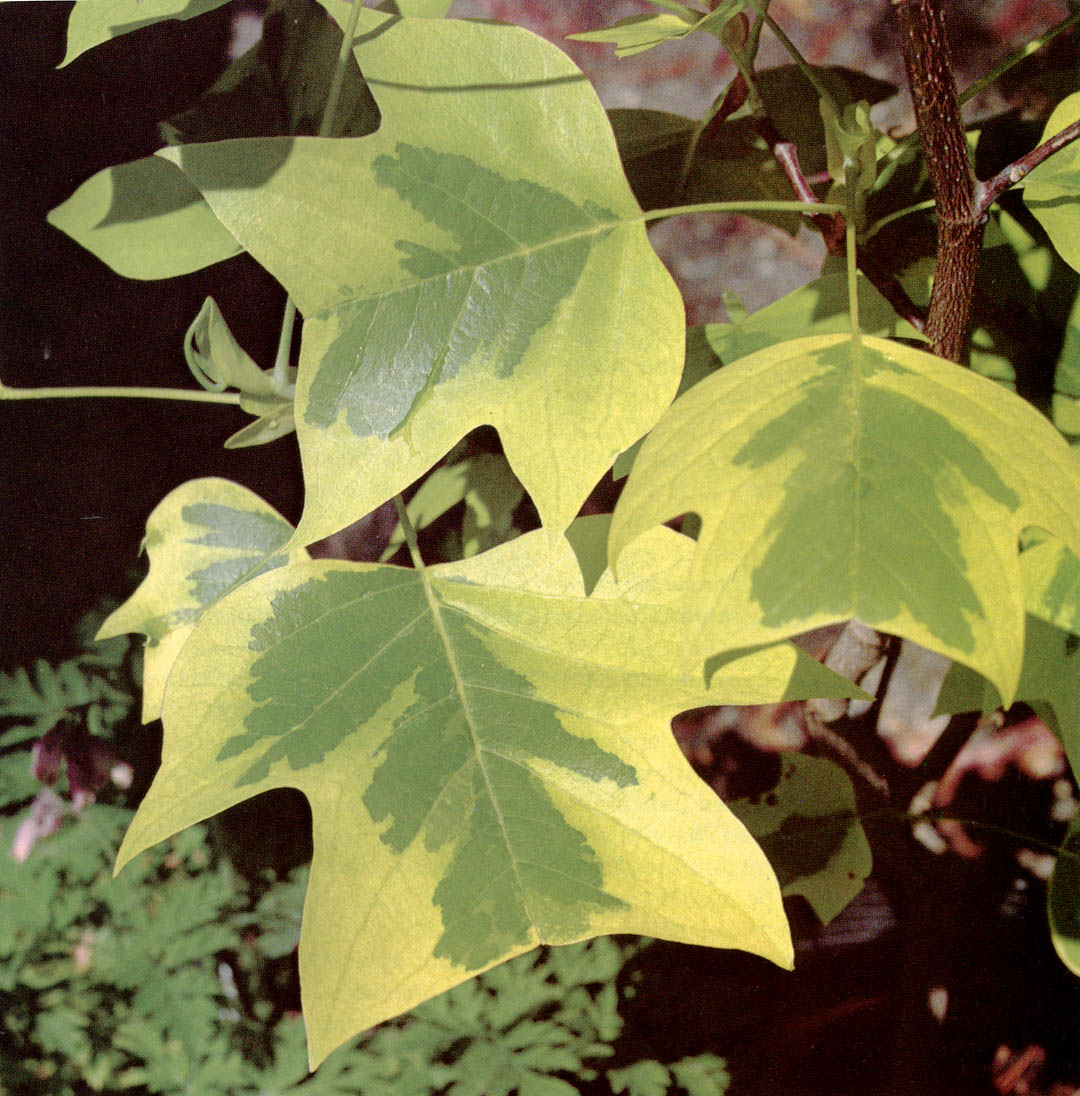
Contributor
- Topics: Archive, Nature is Good For You, Plants You Need
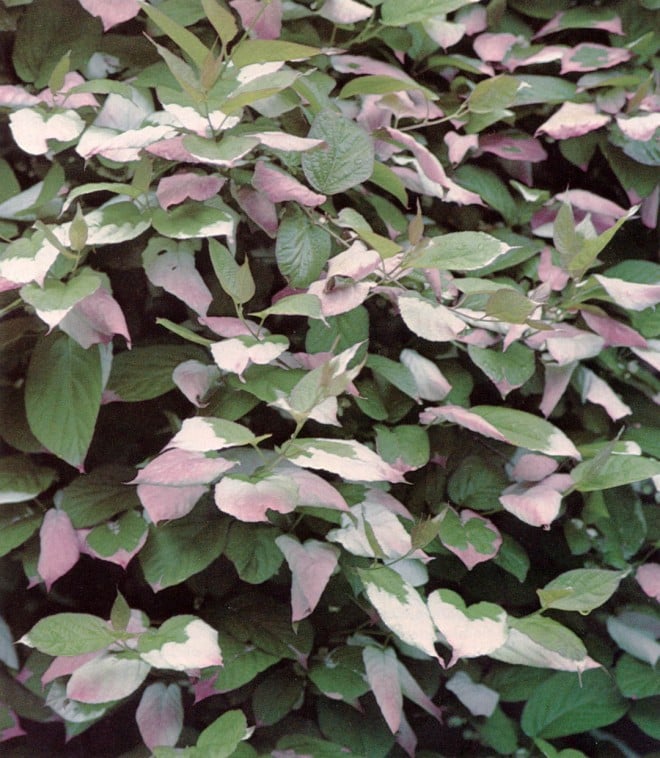
The author’s departure on a protracted horticultural tour in Europe left the manuscript without reference to variegated privet and myrtle. These omissions in no way detract from the value of his survey of the variegated plants of greatest value in western landscapes.
When I think of the great many kinds of variegated foliage and the many effects they can have on those who appreciate them, I feel sorry for my gardening friends who determinedly shut out this entire range of plants from their gardens. Consider, for example, those somewhat anemic beauties with leaves that are partly green and partly cream or white, often with a pink tinge. They include such plants as Actinidia kolomikta and Acanthopanax sieboldianus ‘Variegatus’ and Cornus alba ‘Elegantissima’ — surely these are wonderful and appealingly delicate garden subjects. To persist in thinking of them as sick is somehow analogous to dismissing the more sensitive forms of human communication as neurotic; in both cases there is a graceful departure from a more robust norm. Some prize variegated plants are grown almost solely for the intricate design and color of their leaves, which can be intriguing almost in the manner of flowers. The variegated star jasmine, for example, I find most beautiful when it is not flowering, even though it flowers as abundantly as the plain green one. Another class of shrubs with variegated leaves is grown primarily for its garden effect in the same way as plants with overall colored foliage. In still other cases — and perhaps these are the best of all — varicolored leaves complement and provide a handsome setting for flowers or fruits; perhaps the most exquisite example is the variegated Ampelopsis brevipedunculata, which has masses of white, pink and green leaves among which, in fall, the turquoise and pink berries appear like jewels.
I realize that all this is a little elaborate for some tastes, but I think we must surely long ago have lost those readers who prefer quiet greenery and simple formats for their gardens. For my part, I think broad ranging plant collectors are condemned to baroque effects. Their gardens are perhaps less to be likened to paintings, as Gertrude Jekyll would have it, than to novels that unravel as we travel through, with plots and sub-plots, dramatic confrontations and lots of unexpected and exciting characters — well blended we hope, but at least with distinctive ingredients, blended or not. These are the places where colored and variegated foliage is most apt to be used and enjoyed in a way that can dazzle.
If we plan to use them, there are some things we should keep in mind about variegated plants in general. One is that, since they are at least to some degree lacking in chlorophyll, they are slower growing than their all-green equivalents and more time should be allowed for them to fill their allotted spaces in the garden. Slow growing, of course, is not the same as dwarf. Thus, a new variegated sweet gum is said to be smaller than the non-variegated, but there is a strong possibility that it will in time reach something approaching full height for the species. Another fact to bear in mind about variegated plants is that those with a central blotch of some color other than green on their leaves are far more apt to revert than those with colored margins. I don’t know why this is so, but it is invariably true. To maintain an all over variegated tree or shrub, it becomes necessary to cut out those new growths that are all or nearly all green, and this practice is apt to leave us with a misshapen plant. Finally, some variegated plants must be positioned with considerable care. Most of those with yellow or gold variegations are perfectly hardy to sun, even in very warm climates, but those with cream or white markings are usually considerably more tender. Some of the latter will take full sun without exactly burning, but there is nevertheless a tendency for the white or cream to turn yellowish. Thus, the ideal position for a plant of Actinidia kolomikta is the north side of a tree, hedge or mixed shrubbery, where the delicate whiteness of the plant will be protected and where it can be enjoyed against a darker, shadowy background.
Large Deciduous Trees
One of the most beautiful of all variegated large trees is Acer platanoides ‘Drummondii’ whose large, glossy leaves have a clearly defined white border. The effect of this marvelous tree is one of overall decoration, quite different from that of the ghost tree, Acer negundo ‘Variegatum’ whose leaves are also green and white, but irregularly so and with more white, resulting in the pale tree that justifies its common name. Both of these are excellent in their different ways in the northwest; in California they are best grown where they have some afternoon shade to prevent yellowing of the white parts of their leaves.
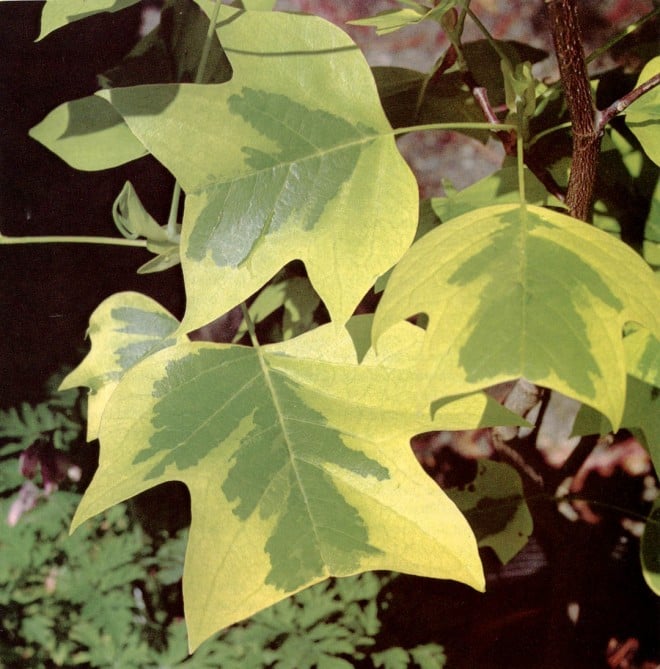
There are several variegated cultivars of the tulip tree, Liriodendron tulipifera, perhaps the best being ‘Aureo-marginatum’ with leaves margined deep gold — a very handsome tree. There is also a form ‘Aureopictum’, which has leaves with a central gold blotch but I have not seen it. Liriodendrons are deciduous trees of large size, and, while I have never seen a full grown plant of L. tulipifera ‘Aureo-marginatum’, it is not difficult to imagine the splendid sight it would be.
Some variegated cultivars of the London plane tree, Platanus acerifolia, have yellow and others creamy white variegations. The most effective of these, I think, is ‘Suttneri’, some large specimens of which can be seen in England. This excellent tree has variegation that includes leaves blotched with creamy white and others that are almost wholly of that color.
I have seen two variegated forms of the sweetgum, Liquidambar styraciflua, one with leaves patterned throughout with yellow and another — the more handsome of the two — with a broad golden edge to its leaves. Both of these are new cultivars. Finally, there are two forms of the Spanish chestnut (I have seen neither). One, Castanea sativa ‘Albo-marginata’, has white leaf margins and the other, ‘Aureo-marginata’, has yellow margins. The latter is said to be a very handsome tree.
Another large deciduous tree I know only by reputation is Populus balsamifera ‘Aurora’ whose foliage was like that of Actinidia kolomikta, large and irregular white variegations which are often flushed pink. A native of central Canada, this tree has been subject to attacks of a bacterial canker in Great Britain, which may or may not occur in our climate. Like other poplars, the tree, I understand, can be pollarded to produce masses of this beautiful foliage.
Large Evergreen Trees
Some years ago a new golden cultivar of Tristania conferta appeared in Western Australia and was seen in California nurseries not long afterward. It has a large central golden blotch in its leaves which makes it a very bright object in the landscape. It is, however, very slow growing. No one knows what its eventual size will be, but T. conferta is a giant of the forest, often two hundred feet high and widespreading.
The variegated Metrosideros excelsa also has leaves with an irregular central golden blotch, and it, too, is a cultivar of a rain forest giant, although, again, no one knows how large it will become in time. Judging from the young plants I have seen, it is an altogether less appealing variegated tree than the tristania, with more of a spotted and less of an overall golden effect. The appearance of the brilliant red metrosideros flowers against this foliage is hard to imagine.
Medium Sized Deciduous Trees
The variegated Cornus controversa is a tree of almost unrivaled splendor. It has lanceolate leaves, considerably narrower than the non-variegated, that are bordered with creamy white and often pink tinged. This marvelous a light, creamy yellow. ‘Karasugawa’ is like ‘Asahi zuru’ except that there is more pink in the white parts of the leaves and the new growth can be astonishingly pink and white throughout before many of the leaves turn green. l must refer the reader to Mr. Vertrees’ excellent study for a better idea of the sweeping range of these remarkable trees and bushes.
Several other oriental maples less well-known than Acer palmatum have cultivars with leaves splashed with white or white and pink. Among these are Acer buergeranum, A. crataegifolium and A. truncatum subsp. mono. One of the most beautiful is A. crataegifolium ‘Veitchii’ with many blotched leaves and others that are wholly white.
Small Evergreen Trees
There are a number of small to medium sized evergreen trees from the southern hemisphere with pleasantly variegated leaves, some of which are just now being introduced into Pacific Coast gardens. The most outstanding of these and one of the most beautiful of all variegated plants is Agonis flexuosa ‘Variegata’. This striking, large shrub or slow growing small tree with its elegant masses of rather small lanceolate leaves appears from a distance to be all over cream and pink. Unfortunately, it is extreme tree grows to thirty-five feet or so with wide spreading, horizontal branches that give it an elegant layered look, and the flat clusters of small white flowers in late spring are beautiful. The tree must be given room to spread in the garden and, if possible, a dark background for a dramatic effect.
Surely no plant in the history of horticulture has had more attention from nurserymen and gardeners in the selection of promising variegated seedlings than the Japanese maple, Acer palmatum. There are forms of this famous tree with red, pink, white, cream, yellow and light green variegations; indeed in a few instances all these colors appear on one plant. In his monograph, Japanese Maples, J.D. Vertrees lists fifty cultivars that are chiefly known for their variegation, a figure that does not include many more that are primarily remarkable for other features but also have variegated leaves. Many of the most striking, in my estimation, have highly irregular variegations more or less in the manner, again, of Actinidia kolomikta (a plant so strikingly variegated that I find it a valuable standard of reference). Acer palmatum ‘Asahi zuru’, for example, has some leaves entirely white and many others spotted white, usually with some pink, all seen against a background of leaves of ordinary coloration. An interesting variant is ‘Kagero’ which has yellow instead of white variegation; here and there about the tree whole patches of leaves will bely difficult to propagate and remains rare even in its native Australia. There are two variegated cultivars of Hoheria populnea, a small tree from New Zealand that blooms copiously in late summer. One, ‘Alba Variegata’ has leaves irregularly margined with white; there is an excellent specimen twenty-five feet high in the Strybing Arboretum in San Francisco. The other, ‘Aurea Variegata’, has leaves irregularly blotched yellow. Both of these plants can easily be kept to shrub size.
The variegated pittosporums are numerous. The two cultivars of Pittosporum tobira, ‘Variegata’ and ‘Wheeler’s Dwarf’ are too well known to need description here. More handsome than these, I think, is the variegated form of Pittosporum crassifolium, which has leaves with creamy white edgings that are gray-felted below, as in non-variegated plants. Similar, except that the leaves are larger and more heavily covered with whitish indumentum, is P. ralphii ‘Variegatum’, one of the most prized of all pittosporums in New Zealand. P. eugeniodes with its wavy-edged, light green leaves is always a cheerful small, narrow evergreen tree, and its variegated cultivar with white leaf margins is still lighter and more pleasant.
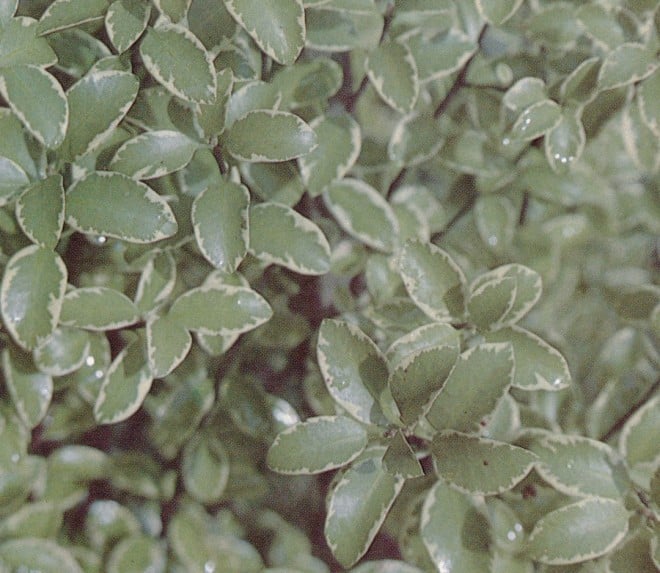
Recent years have seen the introduction of a number of variegated cultivars of Pittosporum tenuifolium. The ordinary variegated form makes a striking, silvery small tree, but P. tenuifolium ‘Silver Queen’ has whiter and larger leaf margins and is even more effective. A newer cultivar ‘Rotundifolium Variegatum’ has creamy-white edged very small leaves that show off the black twigs that are a feature of these pittosporums. The cultivar ‘Garnettii’ is similar to ‘Silver Queen’ but has deep pink leaf edges in the winter months, at which time it makes an extraordinarily handsome tree. We have recently acquired a pale golden variegated form of P. tenuifolium for which we have as yet no name. Before we leave the pittosporums, we should note that the Australians are fond of a variegated form of the Victorian box, P. undulatum.
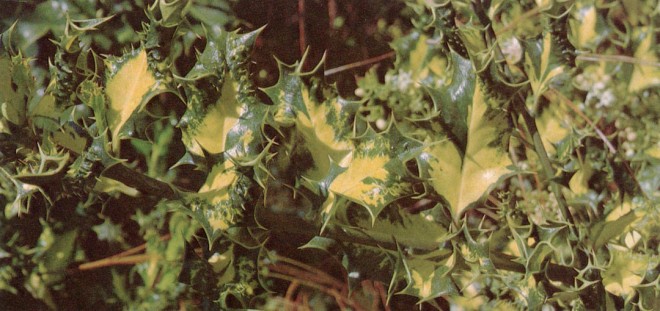
Cultivars of the common holly, Ilex aquifolium, were once among the most frequently seen variegated small evergreen trees. If their vogue has declined it is, I think, partly due to their rather stiff, and therefore some would say, formal, habit and partly because of their association with badly planted and often badly maintained old gardens. This is regrettable, since there are so very many elegant variegated cultivars of this great traditional and deservedly beloved tree. In fact, Ilex aquifolium is for the English what Acer palmatum is for the Japanese; hundreds of cultivars have arisen in the course of several centuries of the cultivation of this plant in the British Isles. In 1874 Thomas Moore began a series of articles in the Gardener’s Chronicle entitled The Common Holly and its Varieties; the series ran in fourteen installments over the next two years. Bean notes that in the eighteenth century holly cultivars were given pleasing common names like Eales Holly or Painted Lady Holly, most of which were lost late in the last century in an unfortunate but fashionable attempt to substitute latinized and scientific names. It was not understood that when vegetatively reproduced, as most cultivars of woody plants are, they remain individuals despite duplication, and individuals, as we know, can only be referred to by proper names. Thus, if a cultivar is called ‘Aurea Medio-picta’ and there is only one plant that can be so described, then the only damage done is to the language. But if there are several cultivars with golden leaf blotches, then the damage is much more serious. Catalogues are then often reduced to describing different selections of ‘Aurea Medio-picta’, which is, of course, a contradiction, since, by definition, each is a separate cultivar. In short, the damage has been great and any number of cultivars have been lost irretrievably because their differences were not recognized and they were denied names. Considerable confusion exists to this day among the remainder.* It is fortunate that, for historical reasons, the Japanese maple did not suffer this fate. (Japanese names become for us, who do not know the language, proper names. Proper names point to unique individuals and are not intended to describe properties which may occur in several individuals.)
[sidebar]
*Further difficulties of this kind are largely avoided by a system of cultivar registration. The register for hollies is maintained by the Holly Society of America whose checklist and Handbook of Hollies should be consulted on matters of naming. They are available from the Society at 304 Northwind Road, Baltimore, MD 21204.
[/sidebar]
One plant of the Aurea Medio-picta group was extensively marketed as ‘Golden Milkmaid’ with the result that many similar plants have become known as golden milkmaid hollies. Some of these are beautiful plants with graceful, irregular golden patches on their shining leaf surfaces. There are both male and female plants with this configuration; the berries are a doubtful addition to the overall effect, but, as Christopher Lloyd has pointed out, the birds soon resolve this issue for you.
The various hollies with gold margins to their leaves were named ‘Aureo-marginata’, which also describes many plants. These gold-edged hollies are often the best of all since they are very colorful and much less apt to revert than plants of the Aurea Medio-picta group. They give decorative effects depending upon the size of the leaves, the width of the gold band, the number of spines and so on, and distinctive names are being given to the best of these. An excellent plant already named is ‘Golden King’ (although it is apparently a female) which has a very narrow gold band around a comparatively smooth, very dark green leaf. ‘Golden Queen’, a female, has smaller, more prickly leaves with a wider but less bright gold edge. There are many more.
The silver blotched hollies came to be called Argentea Medio-picta, and, again, several plants were called silver milkmaid hollies after a cultivar with very wavy, spiny-edged leaves irregularly blotched with creamy white. Two others with almost smooth leaves are called ‘Argentea Picta’ and ‘Lactea Picta’.
The silver edged holly that is frequently seen is known as ‘Argentea Marginata’, but, as usual, there are others that could be so described. There is also ‘Argenteo-marginata Pendula’ with gently weeping branches and ‘Argentea Stricta’ with upright branches.
Mention should also be made of the hedge hog or ferox hollies, with spines on their leaf-surfaces as well as on their edges. Perhaps the best of these is ‘Ferox Argentea’ which has white margins and white spines. ‘Ferox Aurea’ has a golden center to its leaves.
To sum up, I should say that it is difficult to give a good account of the best of the variegated common hollies. There are, however, many beautiful small trees of this class. These, I think, should be propagated, grown experimentally, named and marketed. The holly is often associated with northern gardens and with such plants as rhododendrons and camellias. However, Ilex aquifolium has a wide range in nature and many of its forms are good, fairly drought tolerant and quite reasonably sun tolerant plants for almost all parts of our Pacific Coast Mediterranean climate area.
Ilex x altaclarensis is the name of a group of hybrids between I. aquifolium and I. perado, the Madeira holly, which has, normally, larger leaves than I. aquifolium. The variegated forms of these hollies are handsome, comparatively large-leaved evergreens. The cultivar ‘Belgica Aurea’ has leaves three and a half to four inches long, and one and one-half to one and three-quarter inches wide, edged pale yellow. ‘Golden King’ has leaves three to four inches long by two and one-quarter inches wide, edged rich gold. Another cultivar ‘Lawsoniana’ has a central gold blotch on its leaves. All of these will in time make sizable trees — up to fifty feet.
Several of the many variegated forms of the common box, Buxus sempervirens, are handsome permanent features of the garden. I have never regretted planting boxwoods, although they were at first maddeningly slow. They now form pleasant backgrounds for herbaceous plants as well as occasional columnar or weeping features that are well furnished and never need pruning or care. They are much to be preferred to fast growing shrubs such as xylosmas and pittosporums which soon need cutting back. They have another virtue not readily appreciated but nonetheless real: they are ordinary, or, rather, they have a kind of aristocratic reserve that allows them to fit well into almost any planting.
Unfortunately, boxwoods also suffer from the now old-fashioned effort to give universal latinized names to cultivars. Thus I know of several plants that could be called ‘Argentea’. One is of very narrow columnar growth and has leaves outlined with an extremely narrow white band; another is more pyramidal in habit and has leaves that are more white than green, and there are more that lie somewhere between. Some of these can be used to brighten very dark corners, since box will thrive with less light than almost any other shrub, certainly less than any shrub of its kind; others are excellent wherever a spire-like effect is needed. A very pleasing box is the golden weeping ‘Aurea Pendula’, which has gently pendulous secondary branches and leaves splashed with or wholly yellow.
Two golden cultivars of Elaeagnus pungens are among the brightest of large shrubs for the garden. The best of these is ‘Aurea’, which has leaves margined with gold; and the upper third of many leaves has this same brilliant golden hue. I have seen this plant in England, Canada and New Zealand; it is vastly preferable to those offered as ‘Aurea’ in our nurseries. The cultivar ‘Maculata’ is still brighter, with a large golden blotch in the center of each leaf, but it is, unfortunately, apt to revert and spoil the general effect. The silvery scales for which Elaeagnus pungens is well known add a touch of brilliance which no other shrubs can equal, to its variegated cultivars.
This is perhaps the place to mention variegated cultivars of Euonymus japonica. I am not fond of these plants but they are extremely serviceable in Mediterranean climate areas. The brightest of them, and it is very glossily bright, is ‘Ovata Aurea’, which has leaves margined with rich yellow and which does not easily revert. ‘Aurea’ with a yellow blotch on its leaves is so prone to revert that I think it should never be planted. There are also two with white margins: ‘Albomarginata’ with a thin edging of white and ‘Latifolia Albomarginata’ with a wider creamy white margin. The latter is sometimes marketed as ‘Silver Queen’. (It should by now be obvious that cultivar names suffer markedly from a lack of imagination. However, this does not mean that the plants for which these banal names stand are not often exceedingly beautiful.)
Two sizable evergreen shrubs that are excellent for shady parts of the garden are the variegated cultivars of Osmanthus heterophyllus and Rhamnus alaternus, although, in all other respects, these are such different shrubs it is a little jarring to mention them in the same sentence. The osmanthus has highly decorative, holly-like, silver-edged leaves. It is an elegant, well-behaved shrub, although it will grow into a small tree if left to its own devices. A native of Japan, it needs regular irrigation to look its best. The variegated Rhamnus alaternus is a less elegant and less dense shrub, and its individual leaves have no great beauty. It is, however, lighter, brighter and more cheerful, and it is a tough native of the Mediterranean that will not only take drought but will also compete with the roots of nearby trees.
Deciduous Shrubs
There are a number of supremely beautiful large deciduous variegated shrubs. In fact, as a class, these are more effective than their evergreen counterparts, although, naturally, not in winter. In most cases, their new growth in spring is somewhat lacking in chlorophyll and therefore tends to assume shades of pink, lavender, cream or very pale green, and this, in itself, often makes these plants worth growing. Then, too, the overall freshness of the foliage in early summer together with the normally thinner and greater frailty of the leaves make for an exquisiteness that evergreens usually lack. Frequently, again, being somewhat low on chlorophyll, the leaves often assume beautiful pastel hues as they fall. The price paid for this is the tired look of so much deciduous foliage in late summer and, of course, bare branches in winter.
There are perhaps no more beautiful variegated shrubs than the two cultivars of Aralia chinensis, one with broad silver, the other with gold edges to its leaflets, ‘Albo-Marginata’ and ‘Aureo-Variegata’. Allowed to luxuriate in part or full shade in a damp spot, these large shrubs will in time form impressive clumps of brilliant foliage, crowned in late summer with creamy masses of flowers in panicles up to two feet long. Since they are difficult to propagate, they are fated to remain rare and expensive plants.
Acanthopanax sieboldianus is a smaller shrub in the Araliaceae that also has smaller and more delicate leaves and leaflets. In its variegated form these are bordered with creamy white. It is, as Bean has remarked, one of the daintiest of variegated shrubs. There is perhaps no more effective plant for the shade garden or the back of the perennial border.
Among the aristocrats of variegated shrubs is Cornus alba ‘Elegantissima’ which also has the coloring of Actinidia kolomikta; some leaves are edged white while others are nearly all white. On C. alba ‘Spaethi’ I shall again quote Bean, since I know of no better judge of trees and shrubs:
Undoubtedly the handsomest of all variegated cornels and perhaps the most effective of all deciduous yellow variegated shrubs in cultivation. A mass on a lawn has the most striking aspect all the summer through, for the plant has the great virtue of never having its foliage scorched by summer sun, although the major part of the leaf is bright yellow, nor does it become dull as the season advances, like so many of the shrubs of this color do.
A larger shrub, the cornelian cherry, Cornus mas, also has two good variegated cultivars. C. mas ‘Aurea-elegantissima’ has leaves with a wide border of soft yellow tinged pink. C. mas ‘Variegata’ has creamy white markings, again with a pink tinge. The cornelian cherries are also valuable for their late winter flowers which are yellow and in hanging panicles.
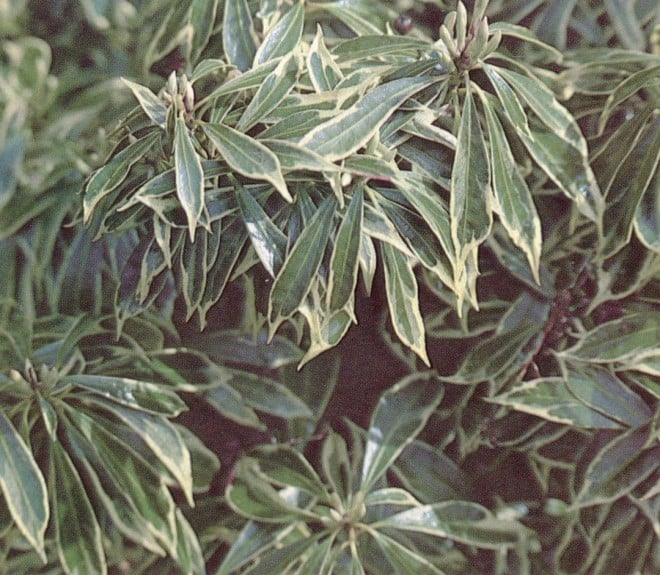
Among smaller shrubs, the most effective I know is the variegated Pieris japonica, which has longer, narrower leaves than non-variegated plants, and these are edged cream. It is rather startling when the plant is flowering, because leaf color and flower color are almost the same. There is also a variegated rhododendron and an azalea, but I find neither of them outstanding. Among very small shrubs, the variegated Daphne cneorum is a rather pretty oddity and the variegated Euonymus fortunei ‘Minima’ is pleasant. However, I know of no dwarf shrubs that are in a class with the medium and large shrubs described above.
Before we close this somewhat sketchy account of the range of colored and variegated broad-leaved woody plants, note should be made of a handsome class of trees and shrubs whose new growth becomes green by midsummer but whose leaves in spring and early summer can be variously colored. There are by now many such plants although few have appeared in Pacific Coast gardens. A good example is Acer pseudoplatanus ‘Brilliantissimum’ which is a slow growing bush — eventually a small tree — with leaves of a beautiful apricot pink for a long period in spring. Another example is Pieris japonica ‘Bert Chandler’, an Australian grown cultivar whose young leaves are at first bright salmon-pink, then fade to cream and white before becoming green. Berberis thunbergii ‘Kelly’s Variety’, from Australia, has spring foliage with red, pink and white markings, which slowly change and assume green and white variegation. It is to be hoped that these and many of the other cultivars I have attempted to describe will be propagated in our nurseries. Whether our aim is a riotously colorful or a carefully restrained garden, we can achieve the best results only with a wide choice of plants. Speaking for myself, at least, I know that it is when I have had to make compromises because of the limited availability of plants that overall effects have been least satisfactory.
Share:
Social Media
Garden Futurist Podcast
Most Popular
Videos
Topics
Related Posts

Ground Up Science for Greener Cities with Garden Futurist Dr. Alessandro Ossola
Spring 2023 Listen to the Podcast here. Alessandro Ossola is a scientist who gets very excited about the challenge of climate change allowing for an

Readying Urban Forests for Climate Realities with Garden Futurist Dr. Greg McPherson
Winter 2023 Listen to the Podcast here. “Going from the mow and blow to a more horticulturally knowledgeable approach to maintaining the landscape. And that

Welcome, Greywater, to the Garden
Summer 2022 Oh, summer: delightful warm air, tomatoes swelling on the vine, fragrant blooms on an evening stroll. When it’s warm and rainless, how is

Big Tree-Data and Big-Tree Data with Garden Futurist Matt Ritter
Summer 2022 Listen to the full Garden Futurist: Episode XV podcast here. We are in an environmental crisis right now in many parts of California









Responses